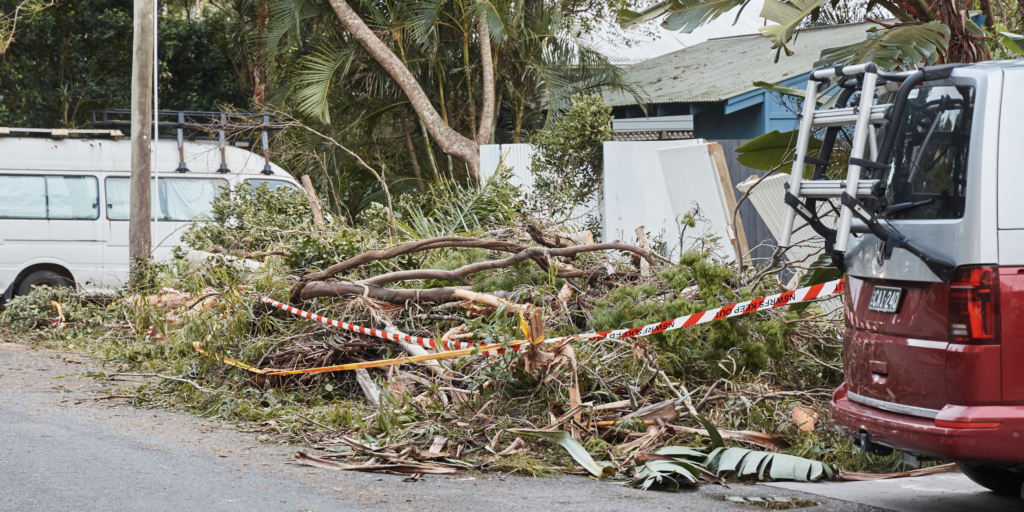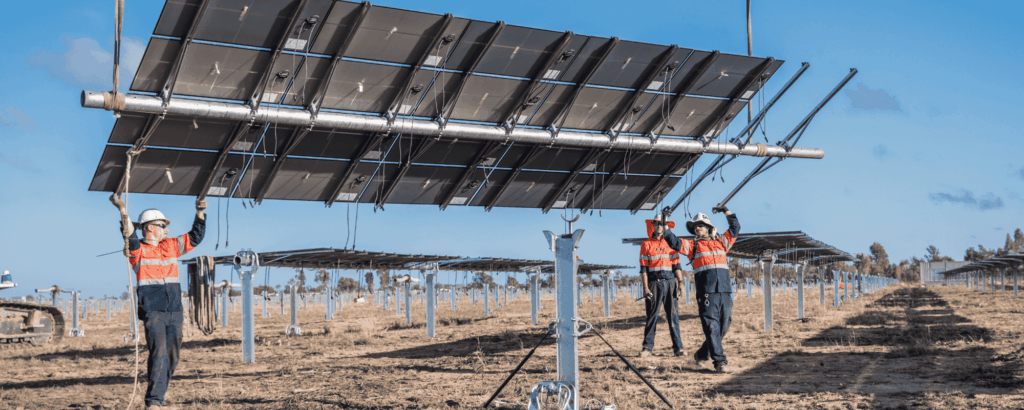The experts at Australia’s leading energy and science bodies, including the Australian Energy Regulator, Australian Energy Market Operator (AEMO), Australian Energy Market Commission and CSIRO, have crunched the numbers to determine the best, cheapest form of electricity for Australia. Their analysis consistently shows that renewable power, backed by storage like pumped hydro and batteries, is the most cost-effective way to keep reliably powering Australian homes and businesses.
Already, more than 40% of Australia’s electricity comes from solar, wind and hydro power – and this is rapidly increasing. At the same time, the share of fossil fuels in our grid is falling. As Australia’s coal-fired power stations age, they are only operating at around 65% of their full capacity, and are frequently breaking down. Coal outages have been a primary driver of power outage warnings in recent years, as well as contributing to some of the most severe price spikes. Australia’s entire fleet of coal-fired power stations is expected to retire by 2038, and 90% of them will shut down over the next decade.
As coal generators reach their end-of-life, there is no question that we must bring new generation online to power our homes and businesses. But what is the most cost-effective way to reliably power our homes and businesses past the end of coal?
How much does power from renewables cost compared to power from fossil fuels?
Renewables are both the cheapest energy projects and the cheapest source of power throughout their lifetimes. This is because unlike fossil fuels, Australia’s abundant wind and sun are infinite, freely available resources. In contrast, coal and gas-fired power stations pay international prices for these fossil fuels, which are subject to international price shocks caused by volatility in the coal, oil and gas markets.
On average in 2024-25, the wholesale price for power from renewables (the price electricity retailers pay, which accounts for up to 40% of our power bills) was $74/MWh – compared to $135/MWh for power from coal and gas.

Why are my power bills still so high if the share of renewables in our grid is increasing?
Although Australia now has a 40% renewable grid, we still rely on expensive, polluting coal and gas for more than half of our power – pushing up power bills. Gas is often the most expensive source of energy in the market today, with high international prices for this fossil fuel playing a big part in driving up household power bills over the past few years. Even though only about 5% of power in Australia’s main grid comes from gas, research from Griffith University shows that because gas is so expensive, gas prices drive 50-90% of pricing periods in the National Electricity Market.
Outages in our decrepit coal clunkers have also contributed to some of the most severe price spikes in recent years – fossil fuel companies take advantage of reduced energy capacity when these outages occur and jack up their prices to maximise profits. For example, in late 2024, coal-fired generators recorded all-time low availability due to planned and unplanned outages. This contributed to higher power prices and several extreme price spikes in New South Wales and Queensland.
Learn more about why your power bills are sky high – and how you can help bring them down.
What would power bills look like if we didn’t have renewables in our grid?
Although power prices have risen significantly in recent years, analysis shows that renewables are already shielding us from even higher prices. A study by researchers at Griffith University found that without the efforts to increase the renewables in our grid, wholesale power prices would be up to 50% higher today.
Into the future, more renewables backed up with storage can help keep power prices in check. If we continued our reliance on coal and gas rather than building more renewables, power bills would increase by $449 a year for households, and $877 for a small business this decade.
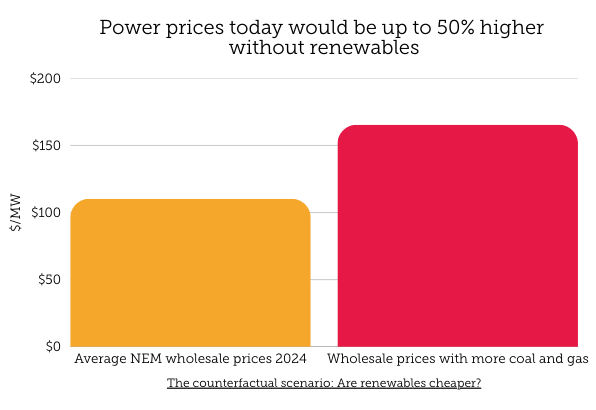
How much do renewable energy projects cost?
CSIRO’s 2024-25 GenCost Final Report found for the seventh year in a row that renewables (wind and solar) backed by storage and transmission are the lowest-cost new-build electricity generation technologies – far cheaper than gas and nuclear. A mix of wind and solar cost between $120 and $170 per megawatt hour (MWh) on average in 2024, while the cost of building new gas generation was up to $199/MWh. Over time, the costs of renewables will continue to fall: by 2030, the costs of renewable projects are expected to be between $76 and $131/MWh.
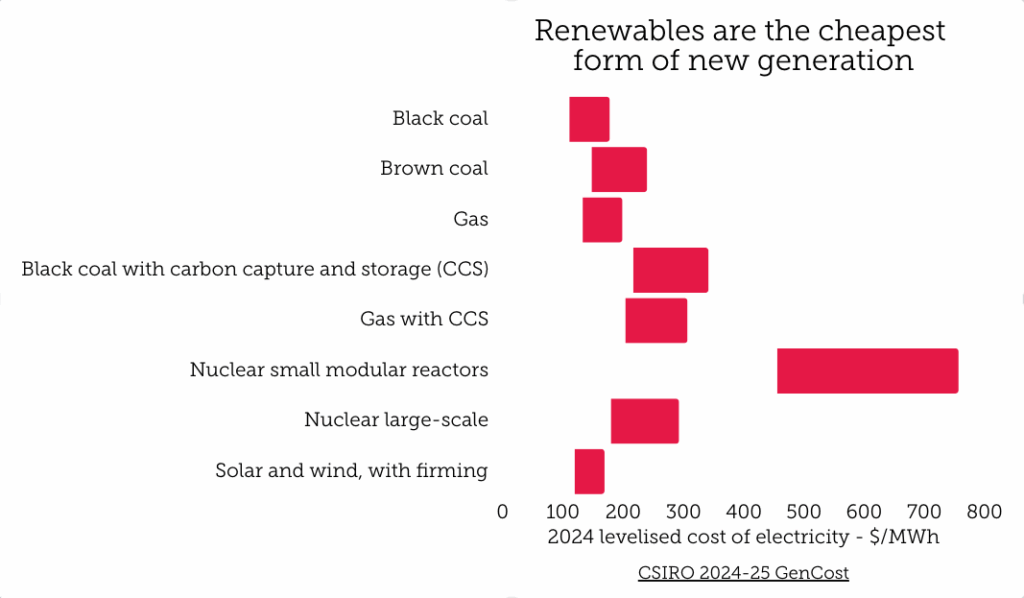
Aren’t energy projects getting more expensive?
While rising construction costs and supply chain constraints are putting upward pressure on some energy project costs, key renewable technologies are bucking this trend. In the past year alone, the cost of battery storage has decreased by about 20%, as the world gets behind renewables and storage. The cost of large-scale solar has dropped by 8% for the past two years in a row.
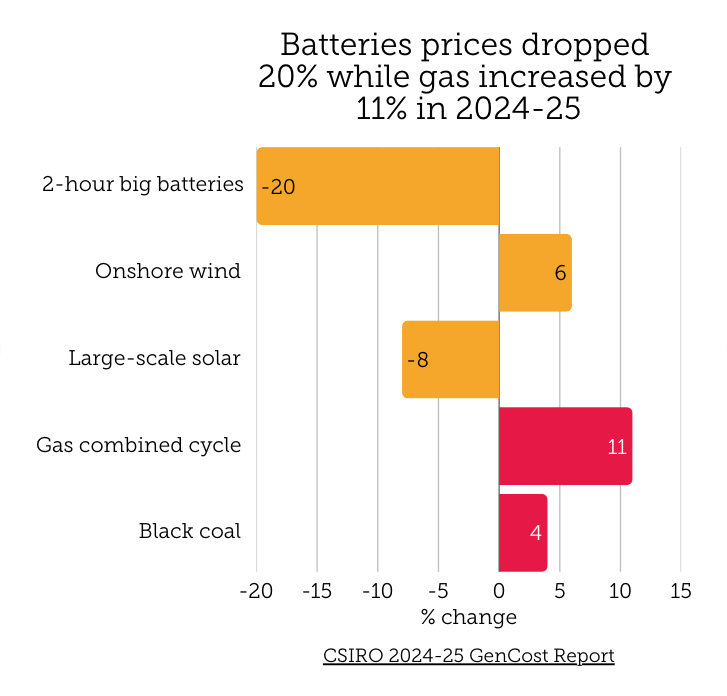
At the same time, costs of new gas generation increased the most – 11% in the last 12 months. The increase is due to limited global manufacturing capacity, leading to long wait times and putting upward pressure on costs. CSIRO expects this to remain the case for at least another three years.
Are renewables a reliable source of power?
Not only are renewables the cheapest option, they are the best way to reliably power our homes and businesses into the future. AEMO has found that large-scale solar and wind, backed up by storage (batteries and pumped hydro), can provide power to Australians 24/7. Different types of renewable energy, like wind and solar, complement each other to provide power around the clock. A combination of household, community and big batteries and pumped hydro can store excess power when it’s available, and make it available later on when we need it. The good news is, battery prices are falling fast: since 2013, global battery prices have plunged by 86%.
Find out more about the important role of batteries in our grid in the Climate Council’s report Battery Boom: Supercharging Australia’s Renewable Rollout.
How do renewable power projects impact Australia’s economy?
Renewable projects bring wide-ranging economic and social benefits to Australia. They are attracting huge amounts of private investment into our economy: renewable projects will inject $68 billion into Australia’s economy over the next five years, and are expected to put $1.3 billion directly into the pockets of farmers and regional communities by 2030 through landholder payments and community benefit sharing funds.
Already, more than 250,000 Australians are powering Australia’s shift to renewables in generation, demand and enabling roles. Around 21,500 Australians directly work in wind, solar, storage and transmission projects in Australia’s main grid, and even more in WA and the NT. Women make up nearly 40% of our renewable workforce – compared to just 23% of the fossil fuel workforce. The shift to renewables will create 33,000 new jobs at its peak in 2029, doubling the current size of the energy workforce. On average between now and 2050, we will need an energy workforce of 52,900.
Projects across Australia are also developing innovative ways to help local communities thrive: from workforce diversity initiatives, supporting farmers and their livestock, and supporting local schools, sports clubs and community groups. Work is also underway to ensure First Nations communities are empowered to share in the economic benefits, job opportunities and access to lower-cost and reliable power.
Read about 11 inspiring renewables projects giving back to communities around Australia in meaningful ways.
In this critical decade for climate action, we can’t afford not to roll out more affordable, reliable renewables
The falling costs of renewable energy and clean technologies are driving down the costs of reducing climate pollution. At the same time, we are already feeling the growing economic costs of inaction on climate change. The total insured cost of extreme weather events in Australia in the first half of 2025 alone has now exceeded $1.8 billion, following Ex-Tropical Cyclone Alfred, the North Queensland floods, and recent flooding on the Mid-North Coast and Hunter regions of New South Wales. The cost of cutting climate pollution is dramatically less than the cost of unchecked climate change, which would cost Australia $4.2 trillion in today’s dollars by 2070.
With the increasing affordability and availability of clean energy technologies, Australia must take strong action to build a renewable, reliable, affordable grid and get off coal, oil and gas as soon as possible – cutting climate pollution, putting downward pressure on power bills, bringing economic and social benefits, and building a safer future for our kids.



